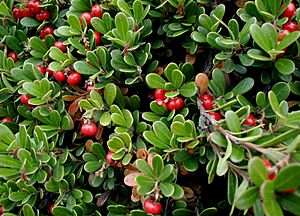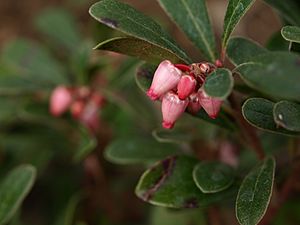Bearberry facts for kids
Bearberries are small, low-growing bushes found in cold parts of the world. They are also known by their Native American name, kinnickinnick. These plants belong to the Arctostaphylos family, which includes three main types of bearberries. Unlike some of their relatives, bearberries are special because they can live in very cold places like the Arctic. You can find them all around the northern parts of North America, Asia, and Europe.
Contents
What Are Bearberries Like?
Bearberries are low-lying bushes that stay green all year round. They often have a rounded shape. These tough plants can grow in sandy soil or even on gravel. In places like Canada, you can find them in northern forests.
Types of Bearberries
The name "bearberry" comes from their fruit, which bears love to eat! Humans can also eat these berries. The leaves of the plant have been used in traditional medicine for a long time.
There are three main types of bearberries:
- Alpine Bearberry: This type is a small bush, usually about 10 to 30 centimeters (4 to 12 inches) tall. Its leaves don't stay green in winter, but the dead leaves often stay on the stems for several years. The berries are dark purple to black. You can find alpine bearberries in very cold, northern areas like Scotland, Scandinavia, Russia, Alaska, Canada, and Greenland. They also grow in high mountains like the Pyrenees and the Alps.
- Red Bearberry: This is another small bush, also about 10 to 30 centimeters (4 to 12 inches) tall. Its leaves fall off in the autumn, leaving bare stems. The berries are bright red. Red bearberries grow in the mountains of southwestern China, eastern Siberia, Alaska, and northern Canada.
- Common Bearberry: This is the most well-known type, often called Arctostaphylos uva-ursi.
How People Use Bearberries
The berries become ripe late in the year and can be eaten raw.
Native American people have a long history of using bearberry leaves. They would gather the leaves in summer and dry them. Sometimes, they used the dried leaves as a substitute for tobacco or mixed them with tobacco.
Bearberries in Traditional Medicine
Dried bearberry leaves can be used to make teas or other remedies in traditional medicine. While bearberry is generally considered safe, taking very large amounts might make you feel sick, causing things like nausea or a fever. It's important to be careful when using bearberry if you are pregnant, breastfeeding, or have kidney problems.
It's good to know that scientists haven't done many studies to prove if bearberry treatments work for human diseases. So, its effects and safety in modern medicine are not fully known.
History and Old Stories
Bearberry was first written about in a Welsh book called The Physicians of Myddfai in the 1200s. Later, in 1601, a scientist named Clusius described it. It was suggested for medicinal use in 1763. The name "uva-ursi" comes from Latin words meaning "bear's grape." Bearberry first appeared in a list of medicines in London in 1788.
Old stories say that Marco Polo thought people in China used bearberry as a diuretic (something that makes you urinate more). Today, bearberry leaves are still used in traditional medicine in parts of Europe.
Native Americans use bearberry leaves in special ceremonies. They might burn them like incense or smoke them in a sacred pipe. This is often called kinnikinnick, which means "mixture" in an old Native American language. When making kinnikinnick, they would mix bearberry leaves with other plants like non-poisonous sumac leaves or the inner bark of bushes like red osier dogwood to make it taste better.
Images for kids





